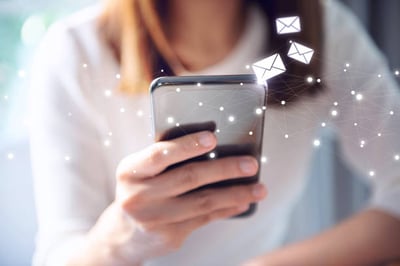June 16, 2021
 by Srilakshmi Janardanan / June 16, 2021
by Srilakshmi Janardanan / June 16, 2021

You know the drill.
You email a bunch of leads every day – even in your sleep at this point. A few respond or click on a call-to-action (CTA). You forget about the rest who don't respond because what's the point, right? But that's not where the buck should stop.
An average inbox receives 121 emails per day. So your all-important email may get buried under thousands of emails in your prospect's inbox. This is the reason why follow-up emails are more important than ever. You need to find a way into the mind and screen space of your target audience.
Not just one or two, but you need to send five emails to make an impact or get a response. Sending emails to the same contact nearly doubles your responses.
By sending follow-up emails, you get another chance for prospects to recall your brand. Follow-up emails raise awareness about what you do and improve the likelihood of persuading recipients to interact with your business.
Say you're an Airbnb host, and you received an email from Airbnb with the subject line "Airbnb's Directed Share Program". The email invites you to buy shares before Airbnb's IPO. You open this email while you are at work or when you are spending time with your kids. Soon, life happens. You wanted to follow up, but eventually forgot about it.
Source: Airbnb Community
It's December 10, 2020. Airbnb goes public, and you remember the email. Why? Because their share doubled since the IPO, and you could have made twice the investment. But you didn't get that follow-up email from Airbnb, and a lot of eligible hosts like you missed out on an incredible offer.
The takeaway? A follow-up email would have helped both you and the business.
Follow-up emails are a sequence of emails sent to a prospect after the first email. They appeal to a basic human trait, one amplified by the information overload around us: forgetfulness. That's why businesses need to go the extra mile and send follow-up emails. These emails jog the recipient's memory and help them recall any previous emails that they received from you.
Follow-up emails:
As soon as you click send, your email will likely get a lot of engagement within the first hour (or at least you hope so!). After 24 hours, the response rate reduces drastically. Your follow-up emails are much more than a click-baity subject line. It shoulders the responsibility of getting opened and doing what the previous email couldn't achieve. The success of your follow-up email depends upon many elements playing their part and delivering the wow factor that can delight customers.
It should appeal to the prospect by being sent at a time they are most likely to respond, contain resources that are likely to draw their attention and persuade them to read, and engage them through visual infographics and targeted information. Applying creativity and a touch of humor can also be rewarding, just like this follow-up email sent by an SDR named Venkat:
Source: LinkedIn
Let’s take a look at some of the must-haves that help you tailor follow-up emails worth responding to.
Before you sit down to craft your follow-up email, you need to define an objective. When you define the objective, you define the outcome you want to achieve. That is – What action should the recipient perform?
The objective of your follow-up email can be:
Keep in mind that besides having a clear objective, you should position it effectively. Your objective should align with the first email you sent and set a pattern for future emails.
If your first email introduced your business to a prospect, your follow-up email could encourage them to receive case studies, industry-specific insights, or product comparison resources.
It is impossible to talk about everything in one single email. Use your follow-up email to include key elements that you may have missed out in the previous email. Creating an outline for your follow-up email keeps you from deviating from the email's objective.
It also clarifies your approach to the email by defining:
The follow-up emails you send are like a second lifeline for you to catch the prospect’s attention. With a clear outline, reduce the time to tailor the message and avoid straying away from the core message.
Your follow-up email should guide your readers to try your product or make a purchase. Emails are effective in capturing your prospect's attention. But you need to rely on phone calls, chats, or video meetings outside emails to turn readers into customers.
By submitting a request to chat further, you achieve two things:
A good follow-up email should include valid contact information to begin an interaction. Ensure that you assign a skilled team member to assist prospects and offer them valuable information.
Your follow-up email works if the information presented in it is relevant to your prospects’ needs. With an incentive, you increase the likelihood of getting a response. Adding an Amazon voucher may not always work. The incentive you offer should motivate the reader to complete the goal you have set.
The ending of your follow-up email is as important as its beginning. End your follow-up email with a clear call-to-action that best represents the action you want the recipient to perform.
Is it to:
To set up meetings, share specifics like date and time or a calendar link. For product sign-ups, add a link that takes them straight to your sign-up page. You can also capture a prospect's email and first name and pre-populate it on the sign-up form to make it easier.
When you send a follow-up email, the stakes are higher because it needs to stay in line with what your first email intended to do. To make it more persuasive, beneficial, and stronger, here are some tips you can apply.
Your subject line is the elevator pitch of your follow-up email. In fact, 47% of email recipients open emails based on the subject line alone. Keep it short, relevant, and straightforward because emails with a subject line of six to 10 words enjoy a 21% open rate.
The ideal subject line length should be seven words or 39 characters as your prospects view emails on small devices like mobile phones, tablets. Optimized subject lines will appear uncut across different screens.
Are you running short of words in your subject line? Use the preview text, also known as pre-header, to incorporate more substance into your subject lines. Tailor your subject line and preview text combo to be helpful, intriguing, and add a sense of urgency.
Good emails are conversational, and great emails are empathetic. Your email needs to put your business second and focus on the prospect's pain point. Write follow-up emails that highlight the reader's problems and how you can help.
When you make your follow-up email reader-centric, it draws them in, connects with them, and drives them to engage with you.
We use our mobile devices for almost everything; making calls, browsing the net, or for contactless payments. And what's that got to do with emails? More than 75% of Gmail users access their accounts through their mobile devices. This means people prefer checking emails on their phones while they work, commute, or during a break.
Your follow-up emails should be optimized to view from different mobile devices. Keep the content of the email concise – consumable in less than one scroll and avoid dense paragraphs. Ensure to highlight links and URLs so that they appear prominent. This will help readers know where to tap in order to complete an action.
Your emails should go to the person who has the authority to call in the shots. One of the reasons your first email remained unopened is because you reached out to the wrong person.
That doesn't mean you should let go. Follow-up emails can help you convince the prospect to connect you with the right contact in their team. If that doesn’t work, give them additional information they need like e-books, catalogs, or content decks. Use the follow-up email to set up a meeting to find out how they can influence the person in charge.
The success of your follow-up email depends upon the value you offer. Think about what your business can do to help the prospect.
If you cannot find out a direct solution, find out ways to improve their existing routine. Most value-driven benefits are how to speed things up, automate email responses, and administrative tasks, or free limited-time access to your product.
If you manufacture kitchen appliances, amateur home cooks can be a potential prospect. While you can't give away your products with every email, your benefit could be an exclusive virtual baking workshop for beginners. With a virtual workshop, you can position your products, reveal clever hacks to make delicious desserts, and win customers.
Emails that resonate with the reader tend to perform better. With personalization, you emphasize how much you value the reader. Personalization turns your email into an exclusive 1:1 communication channel.
But personalization doesn’t mean using the first name merge tag. It means understanding your prospect's persona, relating to what they are going through and the solution they are looking for. This helps you craft emails that are highly personalized and resonate well with your recipients.
When you follow up with a contact more than five times, and there is no response, it's time to rethink your follow-up strategy. But you may have a few telltale signs when:
When you repeatedly email prospects who are not interested, they will mark your emails as spam. This can ultimately hurt your credibility.
Creating follow-up emails takes time, revisions, and more. But if you are running short on time, here are six super useful follow-up emails that you could adapt and include in your follow-up email sequence.
If your business offers downloadable resources on your website, it will attract leads. When users download these materials, you can thank them for downloading and see if they are open to subscribing to your newsletter.
|
Hey {First_Name}, Thank you for downloading our {Downloadable_Type}, {Downloadable_Name}. We hope you find it immensely resourceful in {Purpose_of_the_Downloadable}. Are you thinking about exploring similar content resources? We curate the best of our content on our {Frequency} newsletter and deliver it straight to your inbox. Interested? Click here to subscribe > Happy reading, {Sender_Name} |
In this world of technology, seeing doesn't really mean believing, but experience does. After a demo, a follow-up email ensures that you can bring the prospect closer to signing up. Throw in limited-time access and bring prospects closer to becoming your customers.
|
Hey {First_Name}, We enjoyed having you for our product demo on {Demo_Date} with {Demo_Presenter}. With the demo, we gave you a glimpse of how we could transform your life. But we also want you to experience it first-hand. This is why we've decided to provide you with complete access to {Product/Service_Name} for a week, absolutely FREE. To get started, click the link to sign up and set up your account. Create your account > Regards, {Sender_Name} |
A phone call with your prospect happens after a lot of planning. But now and then, a well-planned meeting sends you straight to voicemail instead. And trust us, voicemail isn't an ideal place to be! This is why sending an email after your call helps you inform the prospect, and lets them know that you've left them a message behind.
|
Hey {First_Name}, We were scheduled to have a call this {Time_of_the_day} at {Time}. But unfortunately, I guess something was up, and you couldn't get to the phone on time. Don't stress too much over it; I left you a voicemail and detailed everything you wanted to discuss! If you need any further information, I'd be happy to help. You can connect with me on a weekday between 9 a.m. and 6 p.m. at {Phone_Number}. Hope you have a great week ahead! Cheers, {Sender_Name} |
Like we mentioned earlier, your C-suite executives are busy. Their time is focused on running the show, and like you, there are hundreds of businesses vying for their attention. So you send out an email to the next person in rank – one who can introduce your business to the leadership team.
But you shouldn't let them go into such a meeting ill-prepared. That's why your follow-up email should have enough resources that they can add to their presentation or demo.
|
Hey {First_Name}, It was a pleasure to interact with you and introduce how our business could be highly significant for your team. We're excited that you'll be meeting your team to discuss this further! I've included a sharable version of our catalog, solutions, and pricing plan in this email. Feel free to use these resources in your demo when you present our solution to your leadership team.
We will be more than happy to help you with any questions you may have. Our team of experts can also walk your team through our business operations and clarify their doubts. Best wishes, {Sender_Name} |
With website tracking and analytics, you can uncover your prospect's behavior. Sometimes, they end up interacting with a specific type of content over and over again.
Your team can use follow-up emails to give your prospect a complete picture of how your business can help them. The follow-up email also presents opportunities to cross-sell by creating a need for a solution, one the prospect was unaware of earlier.
|
Hey {First_Name}, We hope that you found our resources, {Resource_Theme}, extremely useful. We have many content resources that have been a complete hit in our community among people like you. Since you were exploring $Resource_Theme lately, we thought the following articles would add more value to you.
Not what you're looking for? Respond to this email, and we'll be happy to help you get the most out of our {Service/Product_name}. Happy exploring, {Sender_Name} |
Every follow-up sequence needs a befitting end, an email that notifies the recipient that this is your last attempt. This email is typically sent when the prospect has been unresponsive or has not hit the goal you set for them.
Remember that the prospect may not have responded the way you hoped for, but that could change in the future. Which is why the final follow-up should include how your prospect can reach out to you if they change their mind.
|
Hey {First_Name}, You probably remember the first time we emailed you. At that time, we believed that you were excited to know more about us and how {Product/Service_Name} can help you. {Number_of_Emails} unresponsive emails later, we guess that you're either too busy or need more time to decide. And that's ok! We'll be around when you choose to take that leap of faith and begin your journey with us. And when the time comes, we'll be here waiting for you. Feel free to contact us at {Email_Address} or {Phone_Number} when you want to give {Service/Product_Name} a try. Looking forward to meeting you again! Cheers, {Sender_Name} |
Looking for more follow-up email templates? Explore the best practices involved and access free follow-up email templates. If your sales team already sends cold emails, you can use these free follow-up email sequence for your cold email outreach strategy.
There is no right or wrong follow-up email, but the closest email that can capture the attention of your prospects. You can follow the steps we’ve covered, pick a template, personalize the tone and send it to your prospects.
Sending follow-up emails does more than just conversions. It signals your commitment to helping prospects get the best possible experience when they interact with your business.
In a world of automated emails, personalized follow-up emails reinforce the notion that you care for your prospects. It assures them that you value them and are ready to guide them even before they become your customers.
Srilakshmi Janardanan is a Content Marketing Specialist for Freshsales at Freshworks. When she isn’t working on content, you can find her reading, binge-watching a series that’s already over (she hates waiting for the next season), or spending time with her pet, Scooby.
After a successful discussion, what are your post-meeting habits? Do you run off to handle the...
 by Wendy Wang
by Wendy Wang
Most people send emails under the general assumption that they’ll be delivered.
 by Antonio Gabric
by Antonio Gabric
Have you ever given up on a purchase because you didn’t get a response from the brand?
 by Kasia Slonawska
by Kasia Slonawska
After a successful discussion, what are your post-meeting habits? Do you run off to handle the...
 by Wendy Wang
by Wendy Wang
Most people send emails under the general assumption that they’ll be delivered.
 by Antonio Gabric
by Antonio Gabric


